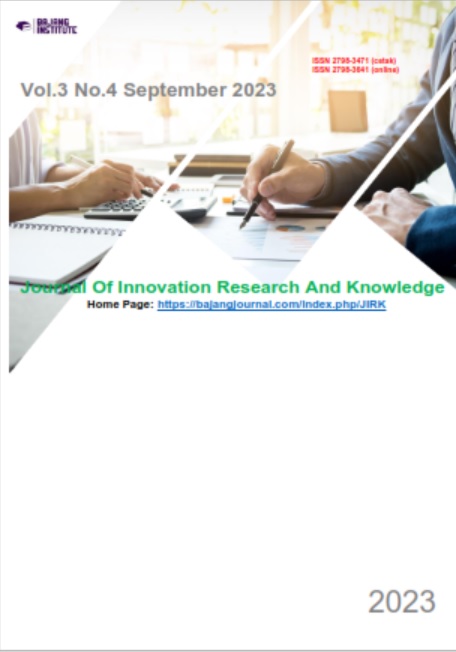KONFLIK PEMERINTAH ADAT DAN PEMERINTAH NAGARI DALAM PENGELOLAAN PASAR TRADISIONAL DI NAGARI DUO KOTO
DOI:
https://doi.org/10.53625/jirk.v3i4.6483Keywords:
Conflict of Interest, Market Development, Traditional MarketsAbstract
Conflict is one of the social phenomena that occurs in market development. Conflicts can occur as a result of revitalization, development or rejuvenation carried out by the government or market managers. Such a conflict occurred between the Nagari Duo Koto Government and the Traditional Government (KAN Duo Koto) regarding the construction of an acaic market in Nagari Duo Koto. The researcher chose to conduct this research because the hegemony of power between the traditional government and the nagari government in market management has caused conflict, thereby hampering the implementation of market development. The problem in this research is what forms of conflict issues and behavior and the causes of conflict between the Traditional Government and the Nagari Government. Apart from that, this research problem also explains how to resolve conflicts between these two equal institutions. To look at this problem, researchers used Ralph Dahrendorf's conflict theory which explains that conflict between power holders shows the existence of unequal power and a malfunction of the rescue valve.
The method used is a qualitative method which is descriptive analysis with two data collection techniques, namely in-depth interviews and supported by data documentation. From the results of the analysis, it was concluded that conflict issues emerged and developed related to market development programs not being implemented, and power holders disagreeing in understanding the applicable laws. The causes of the conflict between KAN and the Nagari Government are the existence of interest factors in the implementation of market development, the failure of the rescue valve in the conflict that occurs, gaps in structure or understanding of information, and the mismatch between formal and informal environments which are also causes of conflict. The conclusion from the results of this research is that Ideas and notions that contain various interests in the implementation of village funds in market development are the main cause of conflict.
References
Arizal, M.A (2014). Metode Penelitian Kualitatif. Jakarta: PT Rajaj Grafinfo Persada
Afrizal. 2018. Sosiologi Konflik. Pola, penyebab, dan mitigasi konflik agrarian struktural di Indonesia. Jakarta: Indomedia Pustaka.
Aridhayandi, M. R. (2018). Peran Pemerintah Daerah Dalam Pelaksanaan Pemerintahan Yang Baik (Good Governance) Dibidang Pembinaan Dan Pengawasan Indikasi Geografis. Jurnal Hukum & Pembangunan, 48(4), 883-902.
Arikunto, Suharsimi. 2006. Metodologi Penelitian. Yogyakarta: Bina Aksara.
Bungin, Burhan. 2017. Metode Penelitian Kuantitatif Komunikasi, Ekonomi, kebijakan public dan ilmu sosial lainnya. Jakarta: Kencana.
Chan, Yusrizal Akmal. 2018. “Tenaga Ahli Program Provinsi Wilayah 2 Sumatera Barat Bidang Pengaduan, Penanganan, dan Masalah.”(Laporan). Padang: Konsultan Pendamping Wilayah.
Dahrendorf, Ralf, 1986.Konflik dan Konflik dalam Masyarakat Industri; Sebuah Analisa- Kritik: Jakarta: CV Rajawali Pers.
Dharmawan, Arya Hadi. 2006. “Konflik-Konflik Kekuasaan dan Otoritas Kelembagaan Lokal dalam Reformasi Tata-Kelola Pemerintahan Desa: Investigasi Teoretik danEmpirik”. Pusat Studi Pembangunan Pertanian dan Pedesaan-LPPM IPB.
Effendi, N. (1999). Minangkabau markets: a picture of an indigenous economic system.
Fahmi Risala, dkk., 2014. “Peran BPD (Badan Permusyawaratan Desa) Dalam Penyelenggaraan Pemerintahan Desa Di Desa Rembun, Kecamatan
Galtung, Johan; Asnawi; Safrudin; Sufyanto. (2003). Studi perdamaian: perdamaian dan konflik, pembangunan dan peradaban / Johan Galtung; penerjemah, Asnawi dan Safrudin; penyunting, Sufyanto. Surabaya: Pustaka Eureka.
Kotler, P., Kartajaya, H., & Setiawan, I. (2021). Marketing 5.0: Technology for humanity. John Wiley & Sons.
M. Legowo and F. Sadewo, Masyarakat Dalam Pembangunan. Surabaya: Unesa University Press, 2018.
Mantrawan, I Putu Wahyu, dkk., 2016. “Peran Elit Desa dalam Partisipasi di Tingkat Lokal dalam Perumusan Musrembang di Desa Blahbatuh Kabupaten Gianyar” dalam E-Jurnal Politika. https://ojs.unud.ac.id
Miall, Hugh, dkk. 2002.Resolusi Damai Konflik Kontemporer, Menyelesaikan, Mencegah dan Mengubah Konflik Bersumber Politik, Sosial, Agama, dan Ras, Jakarta: Rajawali Pers.
Miko, Alfan. dkk, Pemerintahan Nagari dan Tahah Ulayat, Padang: Andalas University Press, 2006.
Moleng, Lexi J. 2017. Metode Penelitian Kualitatif. Bandung: Rosdakarya.
Moleong, Lexy J. 2001. Metode Penelitian Kualitatif, Bandung: PT. Remaja Rosdakarya.
Muzdalifah, S., Sukidin, S., & Suharso, P. (2019). Karakteristik pedagang tradisional di pasar Kepatihan kabupaten Jember. JURNAL PENDIDIKAN EKONOMI: Jurnal Ilmiah Ilmu Pendidikan, Ilmu Ekonomi Dan Ilmu Sosial, 13(1), 94-100.
Nawir, Sikki, dkk. 2004. Pemberdayaan & Penguatan Posisi Masyarakat Nagari dan Langgai. Padang: Jembatan Pemilu dan UNDP.
Nuraini, Siti. 2010. “Hubungan Kekuasaan Elit Pemerintahan Desa” dipublikasikan diJurnal Kybernan.Diakses dari Portalgaruda.org.
Nurhasim, Moch. 1999. Konflik Tanah di Jenggawah, Tipologi dan Pola Penyelesaiannya, Jakarta: PrismaLP3ES.
Pardiyanto, Martinus Aditya.2017. “Konflik Sosial dan Ekonomi Sebagai Dampak Undang-Undang Nomor 6 Tahun 2014 Tentang Desa.”www.researchgate.net.Diakses 30 November 2018.
Peraturan Bupati Agam nomor 26 tahun 2017 tentang Pengelolaan Aset Nagari.
Peraturan Daerah Kabupaten Agam Nomor 1 Tahun 204 tentang Pengelolaan Pasar
Peraturan Gubernur Nomor 16 Tahun 2020 tentang perubahan atas Peraturan Gubernur Nomor 45 Tahun 2019 tentang Penjabaran Anggaran Pendapatan dan Belanja Daerah tahun anggaran 2020
Peraturan Presiden Republik Indonesia Nomor 112 Tahun 2007 tentang “Penataan Dan Pembinaan Pasar Tradisional, Pusat Perbelanjaan Dan Toko Modern”
Redaksi. 2018. “Pemekaran Dikebut, Sumbar Punya 117 Nagari Persiapan”. https://m.jawapos.com. Diakses 30 November 2018.
Saptomo, Ade. 2010. Hukum dan Kearifan Lokal revitalisasi hukum adat nusantara. Gramedia Widiasarana Indonesia. Jakarta
Siwalan, Kabupaten Pekalongan Periode 2008-2014”. Kurniawan, Borni & Tim Infest. 2016. Lebih Dekat dengan Kewenangan Desa.Yogyakarta: Tim Infest.
Soejono Soekanto, Pengantar Penelitian Hukum, Jakarta: UI Press, 1984, hlm. 123-124.
Sumilat, R. D. (2021). Peran Pemerintah Dalam Pengembangan Pasar Tradisional (Studi di Pasar Langowan). POLITICO: Jurnal Ilmu Politik, 10(3).
The British Coouncil. 2001.Mengelola Konflik, Keterampilan dan Strategi untuk Bertindak. London: Zed Book.
Valentina, Tengku Rika& Roni Ekha Putera. 2013“Model Intervensi Negara pada Nagari di Sumatra Barat: Sebuah Analisis Pemecahan Masalah dengan Menggunakan Pendekatan Elit dan Distribusi Kekuasaan”.
Z. Razak, Perkembangan Teori Sosial Menyongsong Era Postmodernisme. Makassar: CV Sah Media, 2017.













